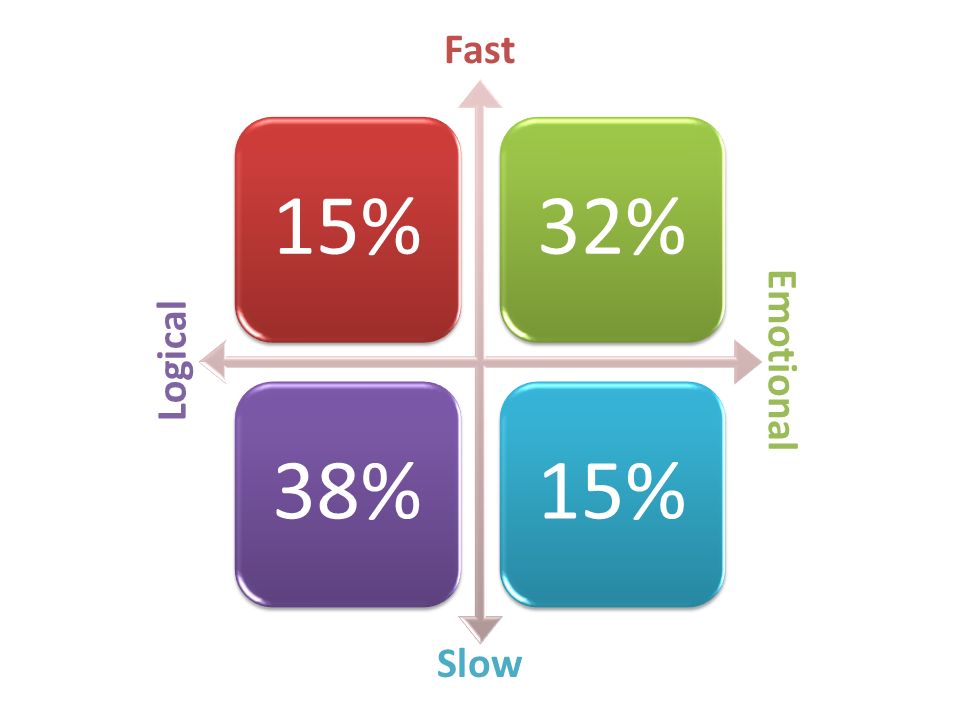Selling to Your 4 Types of Customers
Topic: Entrepreneur Evangelist,Growing Your Business | Comments (1)
 The first thing any marketer will do is say, “Know your audience.” Find out who they are. Write your copy, target your ads and create your videos with your target customer in mind. Know who they are, where to find them and how they buy.
The first thing any marketer will do is say, “Know your audience.” Find out who they are. Write your copy, target your ads and create your videos with your target customer in mind. Know who they are, where to find them and how they buy.
The reality, however, is that even if you are crystal clear on your audience, nearly a century’s worth of Meyers-Briggs personality assessment data shows us that there are still four different decision-making quandrants to consider when crafting your message.
The NT’s
At 15% of the population, this is not a large crowd. However, this is the group in which the majority of CEOs fall, so it’s a safe bet that organizational leaders and decision making authorities often number among this reasonably small part of the over-all population. This group likes data, but they don’t want to have to read through it in detail. And they want to make a decision quickly. So give them their information, and then let them move directly to a purchase opportunity. If you bore them or annoy them with too much information they have to sift through before they can act, you’ll lose them. Their time is typically more valuable than their money, so remember that when talking to (or writing for) them.
The SP’s
This is a much larger segment of the population, at a full 32%. Just like the NT’s, this group likes to make decisions quickly. Unlike NT’s, however, this group is most readily swayed by an emotional appeal. If you can find the emotional key that matters to these buyers, then they are quick to become a customer. Be aware, however, that this customer can also be hard to establish a long-term relationship with, because someone else with a great sounding emotional appeal could lure them away.
The NF’s
Another one of the smallest groups, only comprise about 15% of the population. Like SP’s, this group also consists of emotionally-driven buyers, however these ones like to take their time. No rash decisions, and no hurried impulses. Emotional sway may rule, but not on a whim. This can be a highly loyal customer over time, so treat them well and they’ll be among the best evangelists you could ask for.
The SJ’s
The last group is the largest, coming in at a whopping 38% of the poulation. However, this group is also the most difficult, because they want facts. Lots and lots of details, with all the i’s dotted and t’s crossed. They want everything to line up very logically, and they want to take their time processing through the information to come to a balanced and informed decision.
So, now that you know all this, what do you do with it?
Well, the first thing you don’t do is go out and re-write all of your marketing collateral to target the 38% of the population who are SJ’s. On the contrary, the best thing to do is to find a way to talk to each of these groups. A few tricks to keep in mind when crafting web copy for the various decision-making styles:
- Remember that the web is a non-linear experience. Do not assume that people are going to go from Page 1 to Page 2 to Page 3, like they would in a book. Assume that jumping around is key.
- Recognize that fast decision-makers will almost never read an entire page. Slower, methodical decision makers will make it farther down a page, but even then, too much copy will be wasted.
- Play the logical and the emotional sides whenever you have both. Don’t assume that your company or product needs to pick one or the other. Always remember that one argument will sway some people, and the other will work with others.
- Make sure your call to action (sign-up, purchase, etc.) is clear and readily available from every page. Fast decision-makers are often impatient, and once they decide they are ready to buy, they don’t want to have to hunt around to figure out where to go to do it.
All in all, remember that knowing your customer is only the first step. The next step is then crafting your message to meet the needs of how that customer makes a purchasing decision. Once you stop to consider this, go back and look at your website (or other marketing material) again, and see if it’s speaking to all four quadrants. I’d be willing to bet, you’ll quickly see some opportunities for improvement.
Pingback: Tweets that mention Selling to Your 4 Types of Customers | WorkingPoint -- Topsy.com()